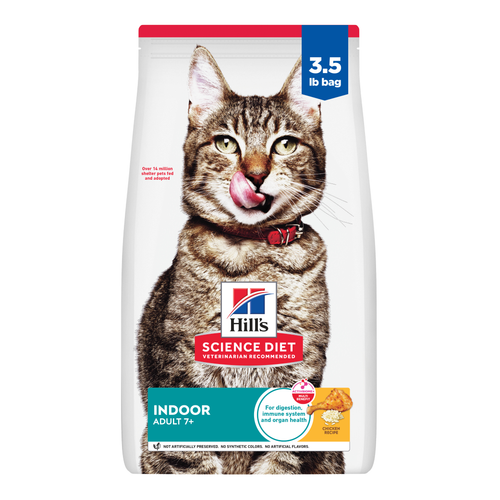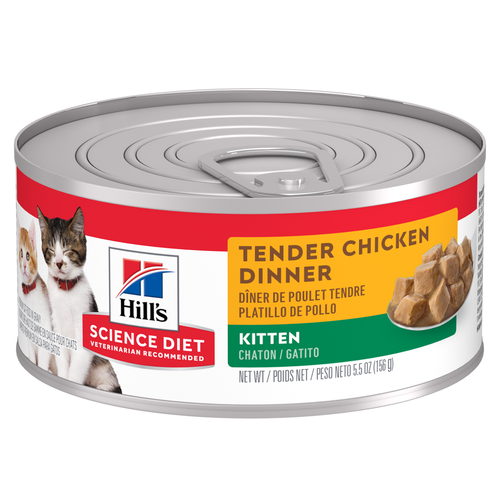
-
Find the right food for your petTake this quiz to see which food may be the best for your furry friend.Find the right food for your petTake this quiz to see which food may be the best for your furry friend.Featured products
 Adult Large Breed Chicken & Barley Recipe Dog Food
Adult Large Breed Chicken & Barley Recipe Dog FoodSupports healthy joints, lean muscle, and beautiful coat for large breed dogs
Shop Now Adult Chicken & Barley Recipe Dog Food
Adult Chicken & Barley Recipe Dog FoodSupports lean muscle and beautiful coat for adult dogs
Shop Now Hill's Science Diet Adult Chicken & Beef Entrée Dog Food
Hill's Science Diet Adult Chicken & Beef Entrée Dog FoodChicken & Beef Entrée in a delicious loaf with complete & balanced nutrition to help keep adult dogs active and healthy
Shop NowFeatured products Adult 7+ Indoor Chicken Recipe Cat Food
Adult 7+ Indoor Chicken Recipe Cat FoodSupports energy level and beautiful fur in mature indoor cats
Shop Now Senior Vitality Adult 7+ Tuna & Vegetables Stew
Senior Vitality Adult 7+ Tuna & Vegetables StewImproves Everyday Ability to Get Up & Go
Shop Now Adult Turkey & Liver Entrée Cat Food
Adult Turkey & Liver Entrée Cat FoodPrecisely balanced nutrition with the delicious taste of minced turkey & liver to help fuel the energy needs of cats during the prime of their life
Shop Now -
Dog
- Dog Tips & Articles
-
Health Category
- Weight
- Food & Environmental Sensitivities
- Urinary
- Digestive
- Joint
- Kidney
-
Life Stage
- Puppy Nutrition
- Adult Nutrition
- Senior Nutrition
Cat- Cat Tips & Articles
-
Health Category
- Weight
- Skin & Food Sensitivities
- Urinary
- Digestive
- Kidney
-
Life Stage
- Kitten Nutrition
- Adult Nutrition
Featured articles How to Properly Mix Wet & Dry Pet Foods
How to Properly Mix Wet & Dry Pet FoodsAn Orange cat eating from a bowl filled with mixed food
Read More The Science Behind Our Love for Pets
The Science Behind Our Love for PetsLearn the scientific reasons why we have such strong connections with our pets, and what science says about the love between humans and our furry friends.
Read More What Is Littermate Syndrome? Pet Adoption Guide
What Is Littermate Syndrome? Pet Adoption GuideLearn more about littermate syndrome in dogs and cats and how to successfully navigate adoption and early socialization processes.
Read More -


Feline glaucoma is an eye disease characterized by high eye pressure (aka intraocular pressure). It can cause pain and potentially blindness. The increase in eye pressure is caused by reduced drainage of the aqueous humor — a clear fluid that circulates between the cornea and pupil.
Normal eye pressure in cats generally ranges from 10 to 20 millimeters. Pressure may vary based on the time of day, the cat's level of excitement or anxiety and their positioning. Eye pressure above 25 mm or a significant difference in pressure between eyes — generally greater than 7 to 8 mm — is considered abnormal.
Thankfully, Glaucoma in cats is relatively uncommon compared to glaucoma in dogs. However, the actual prevalence of the disease might be higher since many cases may go undiagnosed due to the often subtle nature of the associated clinical signs.
Causes of Glaucoma in Cats
Causes of feline glaucoma can be divided into two major categories:
- Primary Glaucoma: Primary failure of the eye's ability to drain fluid
- Secondary Glaucoma: An underlying disease that obstructs the normal outflow of fluid in the eye
Primary Glaucoma
Primary glaucoma is hereditary or breed-related and is quite rare in cats. Certain breeds, such as the Burmese, Persian and Siamese are more prone to primary glaucoma than other breeds. The onset of signs typically occurs in one eye first. However, if one eye develops glaucoma, There's a high likelihood that the other eye will eventually become affected as well.
Secondary Glaucoma
Among cats with glaucoma, secondary glaucoma is more common. It occurs secondary to another disease. Getting diagnostic testing to determine the underlying cause of the glaucoma is critical. Once the cause is determined, your veterinarian can recommend appropriate treatment and give a prognosis for your cat's vision loss.
Common Diseases That Cause Feline Glaucoma
The most common underlying diseases that result in feline glaucoma include:
- Neoplasia: Neoplasia refers to an abnormal growth of tissue. Intraocular neoplasia, often a cancerous mass, is the leading cause of glaucoma in cats, with melanoma and lymphoma being the most common types of cancer affecting the eye.
- Anterior uveitis: Refers to inflammation in the front portion of the eye and is a major cause of feline glaucoma.
- Intraocular hemorrhage (Bleeding inside the eye): This most commonly occurs secondary to high blood pressure or trauma.



Tasty Tips
Signs of Glaucoma in Cats
Clinical signs of feline glaucoma are often very subtle and may be difficult for cat parents to notice. Signs of feline glaucoma include:
- Squinting
- Eye discharge
- Dilation of the pupil
- Prominent blood vessels on the white of the eye
- A hazy or blue appearance to the eye
- Loss of vision
In later stages of the disease, the eyeball becomes enlarged and looks bulgy, and blindness sets in. Cats respond to the discomfort differently. In most cases, though, cats don't show obvious signs of severe pain despite this being a very painful condition. Unfortunately, this means that many cats are diagnosed in the late stages of the disease and are already blind at the time of diagnosis.
Diagnosis and Treatment of Glaucoma in Cats
If you suspect your cat has glaucoma, this should be considered an emergency. Your cat should be evaluated by a vet as soon as possible to reduce the risk of further damage to the eye. Vets diagnose glaucoma in cats based upon clinical signs and by measuring eye pressure. Your vet may use multiple devices to do this.
Unfortunately, in most cases of feline glaucoma once vision is lost it can't be restored. In cats with primary glaucoma, vision loss occurs gradually over time, even with treatment. In cats who have secondary glaucoma, the prognosis depends on the underlying disease causing the glaucoma as well as how the underlying disease and the glaucoma respond to treatment.
There are medicines that can help lower eye pressure and treat glaucoma in cats. Topical medicines must be applied consistently, multiple times a day. While it can be challenging to give your cat medicine, it's not impossible and your vet can help you come up with tricks to make your life easier.
Sometimes the recommended treatment for feline glaucoma is surgery to remove the eye. In cats with irreversible blindness or where cancer is the suspected underlying cause of the glaucoma, removing the eye is usually the most appropriate treatment option. Although it can be stressful to make the decision to remove your pet's eye, remember that the eye is extremely painful. Cats actually do very well with this surgery because a source of discomfort has been removed, and they are usually already adapted to vision loss in the affected eye. Even cats that are blind in both eyes can adapt and do very well following surgery.


Jessica Seid is an emergency veterinarian practicing in the New England area. She is a graduate of the North Carolina State College of Veterinary Medicine and has been in the field for more than a decade. When she's not helping patients, she enjoys spending time with her husband, daughter and French bulldog.
Related products

Delectable chunks with tender chicken smothered in a rich gravy

Precisely balanced nutrition with the delicious taste of minced turkey & liver to help fuel the energy needs of cats during the prime of their life

Supports energy level and beautiful fur in mature indoor cats

Improves Everyday Ability to Get Up & Go
Related articles

Learn how to litter train a kitten with this guide to potty training, including when to start litter training kittens and troubleshooting tips.

Discover which cat toys games your feline friend might like, and how they are great sources of exercise. Explore our library of articles to learn more.

When you adopt a cat, you don't just gain a best friend; you also save her life. Here's why getting a cat from a local animal shelter makes so much sense.

Discover how to train your cat, starting with very basic first steps that both reward good behavior and discourage the bad.

Put your cat on a diet without them knowing
Our low calorie formula helps you control your cat's weight. It's packed with high-quality protein for building lean muscles, and made with purposeful ingredients for a flavorful, nutritious meal. Clinically proven antioxidants, Vitamin C+E, help promote a healthy immune system.
Put your cat on a diet without them knowing
Our low calorie formula helps you control your cat's weight. It's packed with high-quality protein for building lean muscles, and made with purposeful ingredients for a flavorful, nutritious meal. Clinically proven antioxidants, Vitamin C+E, help promote a healthy immune system.

